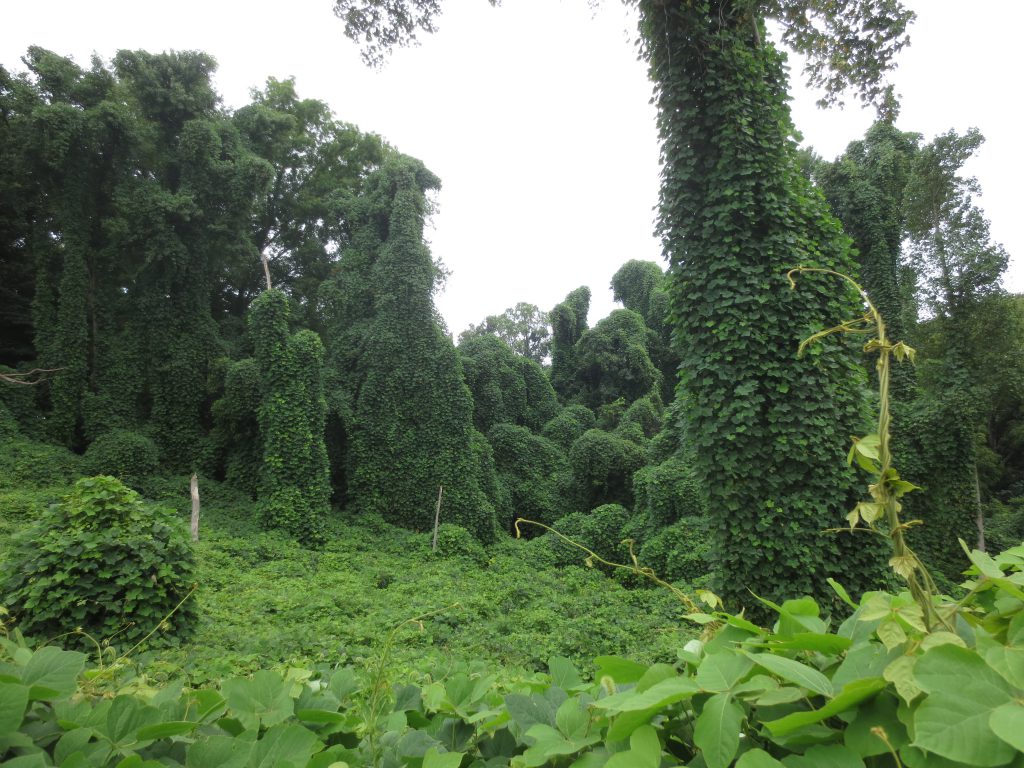Ask an Expert: Spring 2019
Distinguishing between invasive and non-native species; keeping our Eyes on the Bay.
Is there a difference between a species that is invasive vs. one that is non-native? (Arthur in Denton)

Kudzu growing in Anne Arundel County; by Tyler Bell
This is a terrific question, because many people get confused by the terms exotic, native and invasive. In fact, they refer to different and distinct characteristics of species.
“Native” and “exotic” refer to whether or not a species was present in a given ecosystem before a given time: usually the date of European settlement. For instance, everyone can agree that white oaks are native to Maryland because they have been here for thousands of years. Similarly we can all agree that English boxwoods are exotic because they were brought to North America by English colonists.
“Invasive” describes a species that, when introduced into an ecosystem, aggressively establishes itself at the expense of native plants or animals. Mile-a-minute vine, with its amazing growth speed, nasty thorns and ability to entirely smother native plant species, is an example of a species that is both exotic and invasive. Kudzu, gypsy moths and English sparrows are commonly known exotic invasive species.
“Invasive” is also commonly applied to species that cause economic difficulties in cultivated landscapes. The commonest examples are the plants we refer to as “weeds,” many of which are in fact native species that aggressively invade our painstakingly cultivated gardens of exotic species.
So the original home of a species (its nativity) and its invasiveness are not necessarily related terms. Yet the majority of the species that our civilization relies upon are exotic. Wheat, barley and rice are all exotic, but they are not invasive. Cattle are exotic, but also delicious and not usually invasive. And those English boxwood planted around the great colonial mansions have demurely stayed where they belong for hundreds of years. In fact, most exotic species do not become invasive in either natural ecosystems or agricultural settings and it remains difficult to predict whether an introduced exotic will become invasive. But since any exotic could become invasive or be detrimental to the ecosystem, the introduction of any exotic is a bad idea.
–Jonathan McKnight: Associate Director, Wildlife and Heritage Service

Pier on the bay in North East; by Isabel Hernandez
Who monitors water conditions in the Chesapeake Bay and where can I find this information? (Steve in Martinsburg)
The department maintains the website Eyes on the Bay, which provides an array of current and historical tidal water quality data for the Chesapeake and Coastal Bays. Along with our partners in Virginia and the federal government, we collect data with automated sensors at fixed locations throughout the bay and during monthly monitoring cruises. The website also features daily bay satellite imagery and data.
Environmental monitoring data helps us better understand our waters so we can protect and restore our critical natural resources. We measure parameters such as dissolved oxygen, chlorophyll (algae), water clarity, salinity, pH (acidity) and water temperature, as well as nutrient and sediment concentrations. These represent many of the key measures of water and habitat quality for living resources such as fish, crabs and oysters.
Just as our weather varies from hour to hour and from season to season, aquatic habitats are constantly changing as well. Measuring these parameters helps to complete a picture of the current and long-term health of the bay, and guide our efforts to restore and preserve waterways.
Data available on Eyes on the Bay includes both continuous 15-minute increment data and monthly/bi-monthly “calibration data” which is recorded during instrument maintenance visits. Data from our monitoring cruises is available from 1985 to present. Data can be charted, shown in maps and downloaded. Current conditions can be compared to historical ranges, and the health of the bay is shown through “status and trends,” indicating if water quality for various parameters is good, fair or poor and whether it is improving or degrading.
During the summer we regularly release reports from our monitoring cruises through the department’s news web page and through our email bulletins, as well as posts on social media.
Last year we introduced “Click Before You Cast,” a weekly feature that interprets water quality data for anglers. A synopsis is included each week in the Maryland Fishing Report.
If your concern is about safe swimming, local government health departments measure bacterial counts at public swimming beaches. Links to those resources are available on our Eyes on the Bay site.
–Eyes on the Bay Staff: Tidewater Ecosystem Assessment
Appears in Vol. 22, No. 2 of the Maryland Natural Resource magazine, spring 2019.


 1-888-373-7888
1-888-373-7888 233733
233733